Royal Sjealandic Army: Difference between revisions
m (1 revision imported) |
|||
| Line 150: | Line 150: | ||
* [[File:Coat of arms of Allinge-Sandvig.svg|40px]] '''[[Royal Sjealandian Army|1. Division (Feltherrens Division)]]''' in [[Asgård]] | * [[File:Coat of arms of Allinge-Sandvig.svg|40px]] '''[[Royal Sjealandian Army|1. Division (Feltherrens Division)]]''' in [[Asgård]] | ||
** Divisional troops | ** Divisional troops | ||
** [[Royal Sjealandian Army#Structure| | ** [[Royal Sjealandian Army#Structure|I Brigade]] in [[Sjealand|Lusing]] | ||
** [[Royal Sjealandian Army#Structure| | ** [[Royal Sjealandian Army#Structure|VI Brigade]] in [[Sjealand|Sydfjeldsbygd]] | ||
** [[Royal Sjealandian Army#Structure| | ** [[Royal Sjealandian Army#Structure|IX Brigade]] in [[Sjealand|Nordvakt]] | ||
** [[Royal Sjealandian Army#Structure|I Division Support Helicopters]] in [[Sjealand|Fæglevi]] | ** [[Royal Sjealandian Army#Structure|I Division Support Helicopters]] in [[Sjealand|Fæglevi]] | ||
** [[Royal Sjealandian Army#Structure| | ** [[Royal Sjealandian Army#Structure|I Division Artillery Center]] in [[Sjealand|Ørnir]] | ||
** [[Royal Sjealandian Army#Structure| | ** [[Royal Sjealandian Army#Structure|Tynic Engineer Regiment]] in [[Sjealand|Trendeflod]] | ||
** [[Royal Sjealandian Army#Structure|Gudrdalens | ** [[Royal Sjealandian Army#Structure|Gudrdalens Signal Regiment]] in [[Sjealand|Flodborg]] | ||
* [[File:Coat of arms of Haderslev.svg|40px]] '''[[Royal Sjealandian Army|2. Division]]''' in [[Sjealand|Götensholm]] | * [[File:Coat of arms of Haderslev.svg|40px]] '''[[Royal Sjealandian Army|2. Division]]''' in [[Sjealand|Götensholm]] | ||
** [[Royal Sjealandian Army#Structure| | ** [[Royal Sjealandian Army#Structure|VII Brigade]] in [[Sjealand|Yngsvilla]] | ||
** [[Royal Sjealandian Army#Structure| | ** [[Royal Sjealandian Army#Structure|II Brigade]] in [[Sjealand|Nillas]] | ||
** [[Royal Sjealandian Army#Structure| | ** [[Royal Sjealandian Army#Structure|I Mountain Brigade]] in [[Sjealand|Östra Gränsstaden]] | ||
** [[Royal Sjealandian Army#Structure| | ** [[Royal Sjealandian Army#Structure|II Mountain Brigade]] in [[Sjealand|Stöde]] | ||
** [[Royal Sjealandian Army#Structure|II Division Support Helicopters]] in [[Sjealand|Nedansjö]] | ** [[Royal Sjealandian Army#Structure|II Division Support Helicopters]] in [[Sjealand|Nedansjö]] | ||
** [[Royal Sjealandian Army#Structure| | ** [[Royal Sjealandian Army#Structure|II Division Artillery Centre]] in [[Sjealand|Riket]] | ||
** [[Royal Sjealandian Army#Structure| | ** [[Royal Sjealandian Army#Structure|West Sjealands Engineer Regiment]] in [[Sjealand|Götensholm]] | ||
** [[Royal Sjealandian Army#Structure| | ** [[Royal Sjealandian Army#Structure|Brattan Signal Regiment]] in [[Sjealand|Götensholm]] | ||
* [[File:Coat of arms of Sakskøbing.svg|40px]] '''[[Royal Sjealandian Army|Army Support Center]]''' in [[Sjealand|Götensholm]] | * [[File:Coat of arms of Sakskøbing.svg|40px]] '''[[Royal Sjealandian Army|Army Support Center]]''' in [[Sjealand|Götensholm]] | ||
** [[Royal Sjealandian Army#Structure|Logistics and Military Police]] in [[Sjealand|Götensholm]] | ** [[Royal Sjealandian Army#Structure|Logistics and Military Police]] in [[Sjealand|Götensholm]] | ||
** [[Royal Sjealandian Army#Structure|Military Intelligence Center]] in [[Asgård]] | ** [[Royal Sjealandian Army#Structure|Military Intelligence Center]] in [[Asgård]] | ||
* [[File:Coat of arms of Aabenraa County.svg|40px]] '''[[Sjealandic Foreign Legion]]''' in [[Sjealand|Nordvakt]] | * [[File:Coat of arms of Aabenraa County.svg|40px]] '''[[Sjealandic Foreign Legion]]''' in [[Sjealand|Nordvakt]] | ||
** [[Royal Sjealandian Army#Structure|I Regiment]] in [[Sjealand|Nordvakt]] | ** [[Royal Sjealandian Army#Structure|I Foreign Regiment]] in [[Sjealand|Nordvakt]] | ||
** [[Royal Sjealandian Army#Structure|II Regiment]] in [[Sjealand|Varmahlíð]] | ** [[Royal Sjealandian Army#Structure|II Foreign Regiment]] in [[Sjealand|Varmahlíð]] | ||
Revision as of 21:34, 9 March 2019
| Royal Sjealandic Army | |
|---|---|
| Den Kongelige Rigshird | |
Emblem of the RSA | |
| Founded | 6 July 1280 (744 years, 4 months |
| Country | |
| Allegiance | Frederik VI of Sjealand |
| Branch | Army |
| Type | Land warfare |
| Size | 43,355 active soldiers and 20,320 conscripts 2633 tracked vehicles 9948 wheeled vehicles 312,000 reservists |
| Part of | |
| Garrison/HQ | Hærens Operative Hovedkvarter, Asgård |
| Nickname(s) | Fodtusserne, Muddermatroserne |
| Patron | Tyr and Frederik VI of Sjealand |
| Motto(s) | Because some things are worth fighting for |
| March | The day i went to war] |
| Mascot(s) | The brave infantryman |
| Anniversaries | 5th of March (Launching of the War of Vengeance |
| Equipment | Equipment of the RSA |
| Engagements | War of Vengeance |
| Website | https://www.Hæren.sje |
| Commanders | |
| Chief of defence of the Sjealandian Armed Forces | |
| Commanding General | |
| Commander in Chief | Frederik VI of Sjealand |
| Famous commanders | Håkon Bang August Baggesen August Baggesen Axel Otto Mörner |
The Royal Sjealandic Army (Tynic Den Kongelige Rigshird) is the principal land warfare force of Sjealand. Its is the largest branch of the Sjealandian Armed Forces, and is charged with defending the southern border at the sydfjeldene mountains, aswell as defending Sjealands lengthy coastline. It focuses its training on the defence of Sjealand against invasions and frequently develops new plans to defend areas of Sjealand, and as such is deemed one of the militaries most capable of defence in the world. In recent years it has begun focusing more and more on operations outside of Sjealand. It is legally allowed to deploy 10,000 men worldwide without parlimentary approval of a war bill.
The Royal Sjealandic army is formally commanded by the reigning Sjealandic Monarch, which presently is Archking Frederik VI. It is however De Facto commanded by the Chief of Defence Ulrik Ihlefeldt and the Commanding General Ingeborg Kjerstad
History
Late Middle Ages and gilded age
In the ending years of the 1200's as Sjealand was embroiled in the catatrophic civil war known as the Halmsfeld Heresy a combined army made up of Swastrians from several smaller states crossed the border into Sjealand and laid waste to the country, defeating many Sjealandic armies thrown against them and taking vast swathes of land. The failure of the conscripted ledingshær against the Swastrian invaders prompted the Sjealandic monarchy to look for newer ways to defeat the heavily armed and well trained Swastrians. It was eventually decided in 1292 that establishing a permanent professional army to protect the borders would be necessary
17th and 18th century
Crisis of the 19th Century
Early 19th century and the Continental War
Ankoreni Revolutionary War
Sjealand had since the War of the Nautasian Seas, in which the Erkemen Empire ceded 3 ports to Sjealandic control as part of a trade-agreement, had a military presence in Nautasia. In the 1620's Sjealand had also gained considerable influnece in the Beylik of Midillü until 1627 when Bey Mutaharten Çubukoğullari signed a treaty with the royal government officially becoming a protectorate state of Sjealand, and allowing a significant military and economic presence on Midillü and the neighbouring islands of Susam and Değirmenlik. By 1920 this presence included 2,500 Sjealandic troops spread out over 6 different treaty-cities in mainland Ankoren as well as 2 coastal defence ships in the city of Kara Baba. Furthermore a 3000 man strong garrison was located on Midillü. All of these garrisons were supplemented with local militias and zouaves. As a result of the Great War of the North and the loss of Hvidland, increased effort had been put to the remaining possessions of the Sjealandic crown, especially Midillü, which had seen modern coastal guns and machine-gun emplacements. Especially around the local capital of Ballibadra. A significant sum of money had also been given to the Bey's government for a modernization of the infrastructure.
The Ashura Revolution caused a heightening of military presence in the treaty ports and locals were conscripted into local militias, though with questionable loyalty, ships containing weapons and ammunition were also dispatched from Midillü. Sjealandic forces first engaged with the forces of Hossein Shahrestani and the newly formed Union of Ankoren-Pasdan in February 1924 when a 5,000 man strong force surrounded and besieged the treaty port of Hurpişte. Quickly the 1,200 man strong local militia defected to the Anko-Pasdani side, pushing back the 200 Sjealandic soldiers and 500 zouaves to the Sjealandic quarters by the port, which were walled in and defended with machine-guns. While better equipped and trained than their Anko-Pasdani counter-parts the Sjealandic forces were vastly outnumbered, but still managed to hold back the Anko-Pasdani advance for two weeks of bloody urban combat during which the Sjealandic Gevær M/1 proved its effectiveness. The arrival of General Recep Adanir and his 22nd Infantry Division did however spell the end of significant resistance in Hurpişte, as a bloody artillery bombardment saw the surrender of Sjealandic forces on the 23rd of February. The same scenarios continued in 4 other of the Sjealandic treaty ports, with the soldiers mounting significant resistance but at high losses.
However in Kara Baba, the largest and oldest of the treaty ports, the local militia of 3,000 did not defect and were instead declared the Sjealandic-Ankoreni Legion by local govenor Hjalmar Schaft. Bolstered by retreating soldiers from Hurpişte and other towns further bolstered the Sjealandic and zouave numbers by 800, ending up with a force of 3,000 militiamen, 1,200 Ethnic Sjealandic soldiers and 2,000 Zouaves. Supported by the coastal defence ships KSS Nautasien and KSS Ypperligheden efforts to fortify the city began, led by the ethnic Ankoreni engineer Korkut Kizilirmak. These efforts were sorely needed, as Sjealandic neglect had left the defences of the city itself lacking, with only the governmental palace and the barracks properly defensive. In the end they proved effective, as the Sjealandic Forces managed to hold the city for 5 months, until orders from the General Staff for Nautasia ordered a full retreat to Midillü, which was achieved without losses, as several battleships hammered the Anko-Pasdani forces.
With all mainland possessions in Nautasia lost, the Sjealandic soldiers on Midillü spent all their time preparing for the inevitable Anko-Pasdani attacks. Soldiers and equipment dispatched from Sjealand would arrive in the winter of 1924, unopposed by the Anko-Pasdani naval forces, who were busy with the Luziycan resistance. As such the majority of 1925 was used for preparing defences on Midillü until news of the inevitable Anko-Pasdani offensive were heard. In comparison to the 8,000 soldiers on the islands over 32,000 men had been dispatched to the islands by the Union along with a large part of the Anko-Pasdani Navy, including the dreadnought UNS Devrim. These forces landed in November 1925 relatively unopposed but were quickly bogged down in trench warfare against the Sjealandic forces, leading to a slow crawl across Midillü towards the capital Ballibadra which was reached in April 1926, with heavy shelling from the Anko-Pasdanis eventually breaking the Bey's resolve, and he turned against the Sjealandic forces, who surrendered on the 5th of May 1926. Evacuating to mainland Sjealand with their remaining equipment.
War of the Njord
Late 20th century
Modern History
Recent deployments and engagements
Structure of the army
The structure of the RSA has been subject to heavy change every since the end of the War of the Njord, with incredible efforts being put on the ability to defend Sjealandic territory and for the cooperation between the different groupings of the army in the event of Totalforsvar. Following a structural reform in 2004 the RSA now consists of two divisions with the I Division maintaining responsibility for western Sjealand and the II Division maintaining responsibility for eastern Sjealand. Additionally four independent units operate under the jurisdiction of the Army Tactical Staff, namely the Hunter Corps (Special Forces) as well as the garrisons of Asgård and the Tårnøerne, manned by [[conscripts in RSA. These units recieve four months of training in the HGU or Hirdens Grunduddannelse (English: Army Basic Education) and then 5 months of service garrisoning their respective areas. Additionally the Royal Life-Guard Brigade in Asgård and Kolbæk serves in a protective role for the Sjealandic monarchy. The majority of units are stationed close to and around the Sjealandic land border with Swastria as well as the island borders with Vestmannaland and Ambrose with a focus on flexible defence in the outer islands with possibility of giving ground for better defensive positions inland.
While divided into two divisions, the I and II divisions are not standing combat formations, as the spectrum of defence in Sjealand calls for greater flexibility. In daily operations the single brigades operate closer with nearby brigades as well units and squadrons of the Royal Sjealandian Air Force and the Royal Sjealandian Navy than eachother, mainly because of the relatively smaller size of current domestic operations. Earlier the RSA had separate dedicated logistical and support brigades, but after 2004 these were disbanded and the battalions inserted into the existing brigades. The divisional artillery, helicopter and support units do however operate on a larger spectrum.
A standard sjealandic mechanized infantry squad (MEKINFGRP) issued with an APC typically consists of:
- Squad leader (Gruppefører/GF), sergeant, armed with a Gevær M/04
- Rifleman 1 (Gevær 1/GV1), second in command and grenadier, armed with a Gevær M/04 and a grenade launcher
- Rifleman 2 (Gevær 2/GV2), primarily AT-soldier, armed with a Gevær M/04 as well as a PVV M/19. My after order also bring a grenade launcher
- Rifleman 3 (Gevær 3/GV3), medic and secondary AT-soldier, armed with a Gevær M/04 as well as a PVV M/19.
- Light machinegunner 2 (Let maskingeværskytte 2/LMG2), first, armed with a LMG M/60
- Light machinegunner 1 (Let maskingeværskytte 1/LMG1), last, armed with a LMG M/60}
Army Tactical Staff in Götensholm
- Divisional troops
- Jægerkorpset (Special Forces) in Asgård
- Royal Lifeguard Brigade in Kolbæk
- Capital Garrison in Asgård
- Asgård Garrison in Tårnøerne
1. Division (Feltherrens Division) in Asgård
- Divisional troops
- I Brigade in Lusing
- VI Brigade in Sydfjeldsbygd
- IX Brigade in Nordvakt
- I Division Support Helicopters in Fæglevi
- I Division Artillery Center in Ørnir
- Tynic Engineer Regiment in Trendeflod
- Gudrdalens Signal Regiment in Flodborg
2. Division in Götensholm
Army Support Center in Götensholm
Sjealandic Foreign Legion in Nordvakt
- Schools:
- Hirdens Sergentskole (Army NCO School) in Götensholm
- Hirdens Officersskole (Army Officer School) in Asgård
Equipment
Bayonet, field knife, and entrenching tool
| Model | Image | Origin | Type | Notes |
|---|---|---|---|---|
(NorSme Bajonet) |

|
Bayonet | Only used by the Royal Sjealandian Life Guard, when on guard duty. | |
(NorSme Feltkniv) |
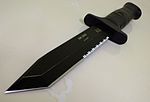
|
Field knife | Standard issued knife | |
(NorSme Feltspade) |

|
Field shovel | Standard issued field shovel | |
(Tyrproduceret Sabel) |

|
Ceremonial sabre | Ceremonial sabre used for parades and given to officers |
Infantry weapons
All rifles, carbines, submachine guns and machine guns issued to conscripts as well as regular personnel in the RSA are equipped with either a A/10 Teleskopsigte or an A/10 Rødpunktssigte to allow the soldier to attach his night vision goggles to optic sight. The optics are assigned upon consideration and depending on the role the soldier fills.
| Model | Image | Origin | Type | Caliber | Notes | |
|---|---|---|---|---|---|---|
| Handguns & Submachine guns | ||||||
(ARL P16) |

|
Pistol | 5.7×28mm | Standard issue pistol | ||
(AKV KMP) |

|
Template:Country data Hethland Hethland | Submachine gun | 11.43×23mm | In use by special forces | |
| Rifles | ||||||
(Asgård Riffelsyndikat Model 1888) |

|
Bolt action repeating rifle | 8×58mmR | Ceremonial rifle | ||
(ARS-MJØLNER) |

|
Assault Rifle | 5.56×45mm | Standard issued service rifle since 2004 | ||
(ARS-STOKAR) |
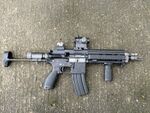
|
Carbine | 5.56×45mm | Carbine version of the ARS-STORM | ||
(ARL F9 TIR) |
Battle Rifle | 7.62×51mm | Standard issue rifle until 2004, still in use by home-guard | |||
(ARS-STORM) |
File:Scar L Standard.jpg | Assault Rifle | 5.56×45mm | In use by special forces and marines. | ||
| Machine guns | ||||||
(ARS EAV-01) |

|
Squad automatic weapon | 5.56×45mm | Battle rifle variant of the ARS-STORM | ||
(ARS LMG-40) |

|
General-purpose machine gun | 7.62×51mm | Standard issued general-purpose machine gun used by infantry | ||
(ARS TMG-50) |

|
Heavy machine gun | 12.7×99mm | Standard issued heavy machine gun used by armored cars, APC's and for gun emplacements | ||
| Machine guns | ||||||
(Diegennis M/02) |
Service shotgun | 12 guage | Used by military police, special forces and for breaching | |||
| Sniper rifles | ||||||
(ARS FSV-01) |

|
Marksman rifle | 7.62×51mm | Marksman rifle version of the ARS-STORM | ||
(ARS SSV-05) |
Sniper rifle | 8.6×70mm or 8.58×70mm | Standard issued sniper rifle | |||
(ARS SSV-10) |
Anti-materiel rifle | 12.7×99mm | Primary used for EOD | |||
| Anti-tank and air weapons | ||||||
(NVF DSK-18) |

|
Anti-tank weapon | 84 mm | Standard issue anti-tank weapon, being replaced by the Panserværnsvåben M/19 | ||
(NVF PVV-19) |
File:AT-4Launcher.jpeg | Anti-tank weapon | 84 mm | Used alongside the Dyssekanon M/18 and slowly replacing it | ||
(MACP-2) |

|
Anti-tank weapon | 127mm | Reserved for larger operations | ||
(MACP-3) |

|
Surface-to-air missile | Primary man-portable air-defense system | |||
| Grenade launchers and vehicle mounted weapons | ||||||
(NVF FSK-13) |

|
Remote weapon station | Used on APC's | |||
(PX-6) |

|
Grenade launcher | Used on APC's, armored cars and emplaced | |||
Infantry grenade launchers and ammo
- GRK M/300 40 mm (NAS-E)
- Brisantgranatpatron M/10 (High Explosive Round)
- Brisantgranatpatron DM504A1 (LV HE Frag Grenade)
- Hulladningsgranatpatron M/17 (High Explosive Dual Purpose)
- Øvelsesgranat (Practice Round)
- Buckshot Round
Grenades and mines
- Håndgranat M/100 (540 grams fragmentation hand grenade)
- Røghåndgranat M/27 (phosphor based grenade)
- Røghåndbombe M/37 (phosphor based grenade)
- Røghåndbombe M/47 (phosphor based grenade)
- M/40 Flashbang device
- M/41 Sting hand grenade
- M/42 CS gas hand grenade
- Alarmmine M/43 (Alarm mine, pyrotechnics)
- Alarmblus M/56 (Alarm mine, pyrotechnics)
Uniforms, personal load-carrying equipment, and personal protection equipment Template:Double image
- Uniformssystem M/110, Standard uniform system in Tynic M/110 camouflage
- Let Kampuniform M/90, light standard uniform system in Tynic M/110 camouflage
- Oppakningssystem M/100, load carrying system (PLCE in Tynic M/110 camouflage)
- Stridsvest M/01, Assault Vest (THOR-RUSTNING)
- Kampfragmentationsvest M/00, body armour (THOR-RUSTNING)
- Beskyttelsesvest M/12, body armour (THOR-RUSTNING)
- Hjelm M/400, helmet (THOR-RUSTNING)
- Hjelm M/450, helmet (THOR-RUSTNING)
- Hjelm M/500, helmet (THOR-RUSTNING)
- Felt-maske M/13, field (THOR-protective mask)
- Felt-dragt M/13, field (THOR-protective suit)
Tactical and communication equipment
- Personalradio M/07, Personnel Role Radio
- Delingsradio M/08, Squad Radio
- Enhedsradio M/09, Platoon Radio
- Sikkerhedspersonelradio M/10, Secure Personal Radio
- Dobbelnat-brille M/100, Binocular Night Vision Device
- Enkelnat-brille M/150, Monocular Night Vision Device
Armour
| Model | Image | Origin | Type | Quantity | Notes |
|---|---|---|---|---|---|
(Tynir SKW 1) |

|
Co-developed by Template:Country data Hethland Hethland |
Main battle tank | 296 | 198 in active service |
(Erlev IKK-1) |

|
Infantry fighting vehicle | 243 | ||
(Poirier T.10) |

|
Armored Personnel Carrier | 884 | Used in various versions:
| |
(Samsme VBPMV-12) |
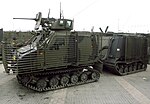
|
Amphibious armoured vehicle | 1,104 | Used in various versions:
| |
(Samsme PMV-2) |

|
Armoured personnel carrier | 1,606 | ||
(Teirland Wjerljocht) |
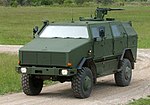
|
Infantry mobility vehicle | 878 | ||
(TV1 Lemming) |

|
Infantry mobility vehicle | 192 |
Engineering and support vehicles
| Model | Image | Origin | Type | Quantity | Notes |
|---|---|---|---|---|---|
(Tynir SKW 1v1) |
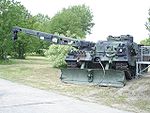
|
Co-developed by Template:Country data Hethland Hethland |
Engineering vehicle | 57 | |
(Tynir SKW 1v3) |

|
Co-developed by Template:Country data Hethland Hethland |
Armored bridge-layer | 49 | |
(Tynir SKW 1v5) |

|
Co-developed by Template:Country data Hethland Hethland |
Engineering vehicle | 21 | |
(Erlev Pansret Brolægger) |

|
Amphibious bridging vehicle | 39 | ||
(Erlev MRF-10) |

|
Mine-clearing Vehicle | 93 |
Aircraft
| Model | Image | Origin | Type | Quantity | Notes |
|---|---|---|---|---|---|
| Ravnen UFF | 
|
Unmanned Aerial Vehicles | |||
| Lods AKH | 
|
Attack helicopter | 36 | ||
| Musvitten FKH | 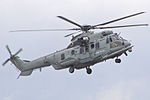
|
Transport | 37 | ||
| Ræven FKH | 
|
Transport helicopter | 45 |
Artillery
Field artillery, mortars, and related equipment
| Name | Image | Origin | Type | Quantity | Notes |
|---|---|---|---|---|---|
| Panserhaubits M/1 (Erlev SKH-2) |

|
Gun-howitzer | 440 | ||
| Selvkørende Haubits M/77 (Erlev PH-1) |
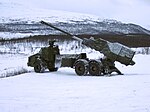
|
Self-propelled artillery | 109 | ||
| Let Mortér M/06 (Mortier Tr. 78) |

|
Mortar | 390 | ||
| Tung Mortér M/10 (Mortier Tr. 91) |

|
Mortar | 104 | ||
| Selvkørende Raketkaster M/15 (Poirier RQ.10) |

|
Rocket artillery | 62 | ||
| Kystautomatkanon M/2 (12cm Kystkanon) |

|
Coastal artillery |
Anti-air systems
| Name | Image | Origin | Type | Quantity | Notes |
|---|---|---|---|---|---|
| 40mm Antiluftskyts (Cannon anti-avion Tr. 34) |
File:Bofors L60 IWM England.jpg | Autocannon | |||
| Land-til-luft missil M/1 (Yver Missilsystem V2) |

|
Surface-to-air missile | |||
| Falange Missil M/1 (Général Phalange) |

|
Missile | |||
| Selvkørende Antiluftskyts M/2 (Tynir SKW 1v4) |

|
Self-propelled anti-aircraft gun | |||
| Let Logistikfartøj M/06-Antiluft M/1 (Erdvung Wehrbagen) |

|
MACP-3 Weapons platform | |||
| Landvogn M/D3-Antiluft (TV1 Lemming) |

|
MACP-3 Weapons platform |
Other vehicles
Trucks, lorries, and other vehicles
| Name | Image | Origin | Company | Quantity | Notes |
|---|---|---|---|---|---|
| Militær Lastbil M/13 (Dyfler Militär-Lastvagn) |
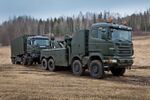
|
Dyfler A/S | 4680 | Used in various versions:
| |
| Let Logistikfartøj M/06 (Erdvung Wehrbagen) |

|
Template:Country data Hethland Hethland | Erdvung | 2300 | Used in various versions:
|
| Let Militær Motorcykel M/04 (Sugan T400) |
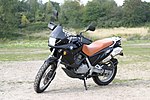
|
Sugan Motor Corporation | |||
| Militær Motorcykel M/05< (Sugan S950) |

|
Sugan Motor Corporation | |||
| Militær Fuldlandsfartøj M/02 (Sechen Lesnik) |

|
Sechen | |||
| Militær Snebæltemotorcykel M/04 (SneFa Soljæger) |
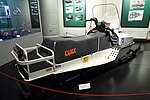
|
SneFa | Used in northern Sjealand and by border guards |
Army Aviation
The Army Aviation Troops (Tynic Hirdens Flyvetropper/HFT) is the primary supplier of direct battlefield aviation support. While the Royal Sjealandian Air Force provides support from combat planes and strategic airlifting, the HFT provides tactical battlefield transport and ground fire-support. The primary attack helicopter is the Lods AKH, an attack helicopter designed and constructed by the Euclean Community. The 36 attack helicopters are equally split between the I and II Divisions in Asgård and Götensholm. Other helicopters include the Musvitten FKH used for tactical insertions, VIP transport, surveillance and reconnaissance. Lastly the Ræven FKH a dedicated intelligence, surveillance, target acquisition, and reconnaissance (ISTAR) helicopter which is also used for battlefield insertions. Additionally the Ravnen UAV is the primary UAV of the RSA, primarily used for target acquisition and surveillance. It is built in-house at the RSA Engineer School.

